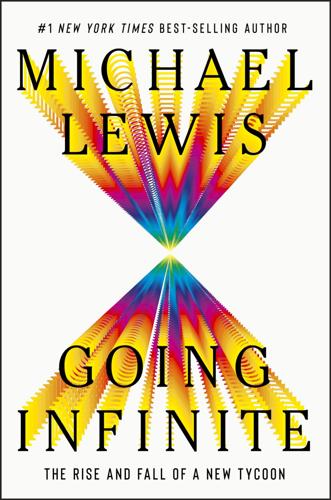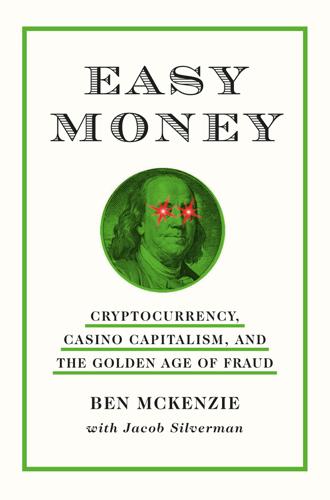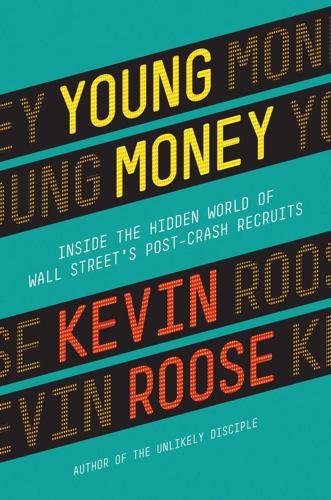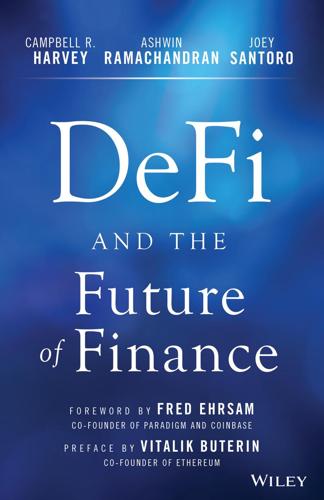Jane Street
description: a proprietary trading firm known for using functional programming languages like OCaml
8 results

Going Infinite: The Rise and Fall of a New Tycoon
by
Michael Lewis
Published 2 Oct 2023
He was surprised when three different high-frequency trading firms emailed him to invite him to interview for their summer internships: Susquehanna, Wolverine, and Jane Street Capital. “It turned out that this was a real thing,” he said. Exactly what it was remained a mystery, even after the firms had reached out to him. You couldn’t just google “Jane Street Capital” and learn anything useful about the place. There was hardly anything about Jane Street Capital on the internet.¶ “I had no idea what to expect,” said Sam. “I didn’t even know what types of interviews these were going to be.” He had three phone interviews with Jane Street traders, and they were like no interviews he’d ever heard of.
…
Tara’s trades were sort of like the trades Jane Street did on everything else, bets on the relative values of different crypto coins. Her success led Sam to his secret belief that he might make a billion dollars by creating a hedge fund to trade crypto the way Jane Street traded everything. But he couldn’t do it by himself. Crypto trading never closed. Just to have two people awake twenty-four hours a day, seven days a week, he’d need to hire at least five other traders. He’d also need programmers to turn the traders’ insights into code, so that their trading could be automated and speeded up. Tara had been making a handful of trades a week on her laptop; what Sam had in mind was an army of bots making a million trades a day.
…
Now they had to decide: Was Sam a reckless, phony effective altruist who was going to steal or lose all their money, or were these other people simply unsuited to working in a start-up hedge fund? It was one or the other, an either/or question, to which they responded probabilistically. Just about all of them kept money invested in Alameda, but just about all of them reduced the size of their investments. The capital at Sam’s disposal plunged from $170 million to $40 million. He wouldn’t be able to trade as much as he had before, but he could still trade. The remaining employees were also in the position of Bob’s friend, in that most of them didn’t understand what had happened. Sam had fully absorbed the Jane Street management technique of letting the rank and file see only their tiny piece of the puzzle, reserving for himself a view of the whole.

Easy Money: Cryptocurrency, Casino Capitalism, and the Golden Age of Fraud
by
Ben McKenzie
and
Jacob Silverman
Published 17 Jul 2023
In order to advance Sam’s EA aspirations, MacAskill offered him a piece of advice: Apply for an internship at Jane Street Capital. The prestigious Wall Street trading firm is known for hiring the most brilliant grads from elite universities. Sam got the internship, excelled in it, and was offered a full-time position following graduation. At Jane Street, Sam could apply his considerable quant skills to figuring out ways to arbitrage minor differences in price to produce massive profits. He was tasked with providing market-making services trading global exchange-traded funds (ETFs). The specifics of that field are not important for us here, just the obvious: At Jane Street, Sam Bankman-Fried was still playing games.
…
“So if you aren’t holding the Tethers, maybe you’re not so concerned about whether Tether could collapse. I mean, do you worry Tether could fall apart?” “So I wouldn’t say not at all concerned. . . . It is important to have a nontrivial amount to be an active market-maker in crypto.” Sam launched into a long-winded explanation of how market makers like Alameda and Cumberland work in crypto. He moved on to stablecoins, and how he thought two of them, USDC and Paxos, were safe. Eventually he turned to what he described as “the other end of the spectrum” risk-wise: Terra, the algorithmic stablecoin that blew up a few months prior.
…
Most people wouldn’t risk too much and will avoid the worst of it, but others who went all in on this crypto madness could lose everything. Lives would be destroyed, and for what? So we could all gamble on fake money? So criminals and fraudsters and Silicon Valley venture capital firms and Wall Street hedge funds could make out at the expense of regular folks? What are we even doing anymore? It’s getting to the point that we, as a country, never hold white collar criminals or politicians accountable. Maybe we’re still in shock from 2016, I ventured. We were scammed by the biggest con man of them all, and our collective exhaustion was blinding us to an obvious, dangerous fraud happening right then, live on cable TV and Twitter and TikTok for all to see.

On the Edge: The Art of Risking Everything
by
Nate Silver
Published 12 Aug 2024
With such a large menu, edges aren’t that hard to find on opening lines. No. What’s hard to beat is the market. Because at some point, Spanky is going to bet the game. Rufus Peabody is going to bet the game. Some fucking hedge fund in Dublin is going to bet the game. And if the bookmaking process is working properly, I have to beat those guys. “Basically, the smartest people in the world who are doing this for a living, trying to make real money from it, are betting into these market makers and moving the markets in real time,” said Miller. “You’re essentially indirectly competing against the smartest, most informationally savvy groups in the world.” The Four Key Skills for Sports Bettors What exactly makes those bettors so savvy?
…
No-Shits-Left-to-Give Sam could get dark and erratic—this was the version that I was a tiny bit worried might suddenly lunge for my digital recorder. Finally, there was Sneaky Sam. This iteration of SBF was pedantic and lawyerly. Although Talking-Shop Sam saw me as an equal, Sneaky Sam was full of gotcha questions, quizzing me as though I was his intern at Jane Street Capital. I got the sense that Sneaky Sam was using me to audition his arguments—if he could outwit me, maybe he could eventually outwit the media, the prosecutors, and a jury. “I’m curious, by the way; what’s your thoughts on that?” Sneaky Sam asked me after claiming that FTX could have averted disaster if only he hadn’t declared bankruptcy and had been able to raise more capital.
…
Ord had been influenced by Peter Singer, and Ord in turn was a huge influence on MacAskill from the moment they got “coffee in a graveyard in the back of St. Edmund Hall,” MacAskill told me. One of the lead writers at Overcoming Bias was Yudkowsky. Hanson and Yudkowsky had something of a falling-out over their competing assumptions about p(doom)—Yudkowsky’s p(doom) is high and Hanson’s is low—and had a debate on AI risk at Jane Street Capital in 2011, the firm that would later employ SBF. Some of the rationalist interest in prediction markets also stems from Hanson, who has expressed his support for futarchy, a system of government where decisions are made by betting markets. These various strands have been tied together from the beginning, the product of a bloggier era in the 2000s and early 2010s when there were fewer people arguing on the internet and the discussion was nerdier and more free-flowing.

Number Go Up: Inside Crypto's Wild Rise and Staggering Fall
by
Zeke Faux
Published 11 Sep 2023
My visit to the penthouse marked the beginning of an apology tour that would, in the coming days, include a video appearance at a New York Times conference and an interview on Good Morning America. In Bankman-Fried’s telling, nobody had been intentionally defrauded. He blamed his firm’s failure on a hazy combination of comically poor bookkeeping, wildly misjudged risks, and complete ignorance of what his own hedge fund was doing. In other words, an alumnus of both MIT and the elite Wall Street trading firm Jane Street was arguing that he was just dumb with the numbers—not pulling a conscious fraud. Talking in detail to journalists about what was certain to be the subject of extensive litigation seemed like an unusual strategy, but it made sense: The press helped him create his only-honest-man-in-crypto image, so why not use them to talk his way out of trouble?
…
When I spoke with MacAskill, he laughed when he remembered Bankman-Fried’s matter-of-fact response: “He basically said, ‘Yep, that makes sense.’ ” Another young MacAskill acolyte had gone to work for Jane Street Capital, a stock trading firm. It was one of a handful of companies that had used mathematical models and computer programs to take over the business of making markets on Wall Street. Anytime someone bought or sold a share of a stock or exchange-traded fund, there was a decent chance Jane Street was on the other side. Entry-level jobs there paid around $200,000 annually. Bankman-Fried secured an internship at the trading firm. And after graduation, he moved to New York to work there.
…
See also Alameda Research betting against Tether, 70 Platinum Partners, 72 as short sellers, 70, 72 as Tether users, 26–27 Held, Dan, 21 Herbert, Stacy, 204–205, 210, 239 Hiaasen, Carl, 14 Hiếu, Ngô Minh, 182–183, 185 “High in the Cemetery” (Morgan), 99 Hilton, Paris, 141 Hindenburg Research, 72–73 Ho, Vicky, 172–175, 180, 183 Hoegner, Stuart, 69 Hollywood Reporter, 155 Hong Kong, 87, 223 “How to Social Engineer Your Way Into Anything” (Morgan), 103 human trafficking, 193–195 Hun Sen, 190 Hurley, Mitch, 240–241, 242 Hydra Market, 108 I Icetoad, 176–177, 178, 179, 182 Il Blog delle Stelle, 43–44 “initial coin offerings” (ICOs) as bust, 87 described, 35 Ethereum and, 113 “pump-and-dump” schemes and, 49–50 Internet Gaming Entertainment (IGE), 34 J James, Letitia, 64 Jan, Richard, 193, 195 Janczewski, Chris, 104–105, 106 Jane Street Capital, 83, 84 Jeter, Derek, 129 K Keeton-Olsen, Danielle as scam compounds guide, 192–195, 196, 198, 199 basic facts about, 191 story about Chinatown, 197 Keiser, Max, 22, 204–205, 210, 239 Kim Jong Un, 127 Knight, Marion “Suge,” 32 Koutoulas, James, 29–30 Kraken, 21, 61 Kramer, Todd, 146 KuCoin, 102 Kwon, Do, 162, 163, 238 L Lai, Lennix, 215 Lansky, Meyer, 76 Lapina, Arthur, “Art Art,” 121–122, 125 Larsen, Aleksander, 123 laser eyes, 22 Latham & Watkins, 59 Lazarus hacker group, 102 Ledger Labs, 102–103 Lehman Brothers, 18 Levine, Matt, 49, 134, 135 Lewis, Michael, 130–131, 236 Liberty Reserve, 37 Lichtenstein, Ilya “Dutch” basic facts about, 98, 100–101, 106 Life magazine, 77 Lincoln, Abraham, 71 Loney, Patrick, 139–140 Loot, 143–144 Lugano, Switzerland, 207, 208, 209–210 Luna, 162–163, 165, 166, 226 M MacAskill, Will, 82–83, 216, 231 Mac Aulay, Tara, 84, 85, 87 Madoff, Bernie, 45, 232 Magic: The Gathering Online eXchange (Mt.

Young Money: Inside the Hidden World of Wall Street's Post-Crash Recruits
by
Kevin Roose
Published 18 Feb 2014
The financial firms in attendance were using largely the same vague pitches I’d heard years earlier at Wharton. One bank advertised its “global transaction advisory for the new economy.” Another offered students a chance to “bring your career into focus.” Jane Street Capital, a medium-sized hedge fund, had a banner promising its recruits a “dynamic, challenging environment. Rapid advancement. Idea-driven meritocracy. Informal fun and open atmosphere.” (Oh, and last on the list: “Generous compensation.”) I walked around the gym for an hour, listening to recruiters attempting to reel in students with time-tested come-ons: “I love my job, and I love what I do.”
…
Patrick wouldn’t say how much money this strategy has made the group, but he did tell me that they haven’t lost money—which is more than many professionally run hedge funds can say. Despite some minor disagreements, there was no yelling or table pounding at the Black Diamond meeting. In fact, the whole thing felt more like an international relations seminar than a hedge fund meeting. “Why would we run to metals if the economy is improving?” Bryce said at one point, after Patrick suggested investing in platinum to take advantage of low prices. “Does anyone think the economy isn’t improving?” Later in the meeting, the group video-chatted with a hedge fund trader from San Francisco, a Harvard Business School graduate who serves as an informal advisor to the group.
…
For many incoming Goldman analysts, who spent their lives acing standardized tests and excelling in varsity sports, the desk scramble represented the first time they ever struggled to measure up. Jeremy had started the scramble with a rotation on Goldman’s prime brokerage desk, a group that provided basic services for hedge funds who held their money at the bank. It was a cold desk whose work amounted to little more than acting as bank tellers to hedge fund managers, and he’d quickly grown bored of it. His second rotation, in equity sales, was slightly better, but still something a trained chimp could do. But his third rotation, in the commodities division, had redeemed the failings of the first two.

DeFi and the Future of Finance
by
Campbell R. Harvey
,
Ashwin Ramachandran
,
Joey Santoro
,
Vitalik Buterin
and
Fred Ehrsam
Published 23 Aug 2021
Order-book DEXs also often have large spreads due to the presence of low-sophistication market makers. Whereas traditional finance is able to rely on sophisticated market makers including Jump, Virtu, DRW, and Jane Street,21 order-book DEXs are often forced to rely on a single market maker for each asset pair because of the nascency of the DeFi market and the complex compute infrastructure required to provide them with on-chain liquidity. As the market evolves, we expect these barriers to break down and more traditional market makers to enter the ecosystem; for now, however, these obstacles create a significant barrier to entry.
…
A platform that facilitates token swapping on Ethereum in a non-custodial fashion is a decentralized exchange (DEX). There are two primary mechanisms for DEX liquidity: an order-matching approach and an Automated Market Maker (AMM). Order-Book Matching Order-book matching is a system in which all parties must agree on the swap exchange rate. Market makers can post bids and asks to a DEX, and allow takers to fill the quotes at the previously agreed on price. Until the offer is taken, the market maker retains the right to remove the offer or update the exchange rate as market conditions change. The order-matching approach is expensive and inefficient because each update requires an on-chain transaction.
…
Table of Contents COVER TITLE PAGE COPYRIGHT FOREWORD PREFACE I INTRODUCTION FIVE KEY PROBLEMS OF CENTRALIZED FINANCIAL SYSTEMS IMPLICATIONS NOTES II THE ORIGINS OF MODERN DECENTRALIZED FINANCE A BRIEF HISTORY OF FINANCE FINTECH BITCOIN AND CRYPTOCURRENCY ETHEREUM AND DeFi NOTES III DeFi INFRASTRUCTURE BLOCKCHAIN CRYPTOCURRENCY THE SMART CONTRACT PLATFORM ORACLES STABLECOINS DECENTRALIZED APPLICATIONS NOTES IV DeFi PRIMITIVES TRANSACTIONS FUNGIBLE TOKENS NON-FUNGIBLE TOKENS CUSTODY SUPPLY ADJUSTMENT INCENTIVES SWAP COLLATERALIZED LOANS FLASH (UNCOLLATERALIZED) LOANS NOTES V PROBLEMS DeFi SOLVES INEFFICIENCY LIMITED ACCESS OPACITY CENTRALIZED CONTROL LACK OF INTEROPERABILITY VI DeFi DEEP DIVE CREDIT/LENDING DECENTRALIZED EXCHANGE DERIVATIVES TOKENIZATION NOTES VII RISKS SMART CONTRACT RISK GOVERNANCE RISK ORACLE RISK SCALING RISK DEX RISK CUSTODIAL RISK ENVIRONMENTAL RISK REGULATORY RISK NOTES VIII CONCLUSIONS: LOSERS AND WINNERS NOTE ACKNOWLEDGMENT REFERENCES GLOSSARY INDEX End User License Agreement List of Tables Chapter 6 Table 6.1 The Problems That MakerDAO Solves Table 6.2 Problems That Compound Solves Table 6.3 Problems That Aave Solves Table 6.4 Problems That Uniswap Solves Table 6.5 Problems That the Yield Protocol Solves Table 6.6 Problems That dYdX Solves Table 6.7 Problems That Synthetix Solves Table 6.8 Problems That Set Protocol Solves List of Illustrations Chapter 2 Figure 2.1 Western Union transfer from 1873 Figure 2.2 Iraqi Swiss dinars and new dinars Chapter 4 Figure 4.1 Linear bonding curve Figure 4.2 Superlinear bonding curve Figure 4.3 Logistic/sigmoid bonding curve Figure 4.4 Different bonding curves for purchases and sales Figure 4.5 The mechanics of automated market makers Chapter 6 Figure 6.1 The Mechanics of MakerDAO's DAI Figure 6.2 Collateralization Ratios in Compound Figure 6.3 Savings and Lending Rates in Compound Figure 6.4 The Mechanics of Compound's Equity Token (cToken) Figure 6.5 The Mechanics of an Aave Flash Loan Figure 6.6 The Mechanics of a Uniswap Automated Market Maker Figure 6.7 The Mechanics of a Flash Swap in Uniswap Figure 6.8 The Mechanics of Fixed-Rate Borrowing in the Yield Protocol Figure 6.9 The Mechanics of Arbitrage with dYdX Figure 6.10 Perpetual Futures with dYdX Figure 6.11 The Mechanics of Synthetix DeFi and the FUTURE of FINANCE Campbell R.

Breaking Twitter: Elon Musk and the Most Controversial Corporate Takeover in History
by
Ben Mezrich
Published 6 Nov 2023
Even for Silicon Valley, the vision on the screen seemed unkempt; as the panda started talking, his words coming so fast they were nearly slamming into each other, the alarm bells began to ring. Elon was no stranger to the mythology that had grown up around the kid: Sam Bankman-Fried, or SBF as he was generally known in the tech press, was considered one of the most brilliant young entrepreneurs of the past decade. After first making a name for himself at Jane Street Capital, then starting his own quantitative trading firm, called Alameda Research, at thirty, SBF had founded FTX, one of the fastest-growing crypto exchanges in the world. The stories about SBF were legendary, and unavoidable. How he’d first pitched FTX to a room full of Sequoia Capital VCs, waxing poetic about making his exchange “a place where you can do anything you want with your next dollar,” from buying crypto to art to goddamn produce, all the while his head hovered inches above his laptop, never once breaking from the screen to make eye contact.
…
If Twitter was the greatest show you could access with your thumbs, Elon was one of its biggest draws. Over the years, he’d developed a personal friendship with Jack Dorsey; the two billionaires shared libertarian philosophies, especially around decentralized money and the importance of freedom of speech. Jack was once again no longer the company’s CEO—likely forced out by Elliott Management, a hedge fund with a major financial interest in Twitter. He had handed the reins off to the company’s chief technology officer, a previously obscure engineer named Parag Agrawal. Still, Dorsey remained an outsized influence on the sensibility of the site, the blueprint for which he’d been the primary architect.
…
It went back further—not six days, to Elon’s Twitter poll and its aftermath, but six months. Parag owed his job to Jack Dorsey—but Jack hadn’t stepped aside quietly, whether it had really been his own decision or someone else’s. It was public knowledge that he had been feuding with Twitter’s board for some time; primarily, he had been in a battle with Elliott Management, the activist hedge fund managing over $50 billion, who owned around 4 percent of Twitter’s shares. It was no secret that Elliott had been searching for a replacement for Jack from the moment they had bought into the company—and apparently, Jack had finally reached his breaking point. Jack’s conflict with Elliott and the Twitter board hadn’t revolved around the financial future of the company, which might have been Elliott’s main focus, but the philosophical direction Jack believed the company was heading.

More Everything Forever: AI Overlords, Space Empires, and Silicon Valley's Crusade to Control the Fate of Humanity
by
Adam Becker
Published 14 Jun 2025
You probably already know the rest of the story. Sam Bankman-Fried’s cryptocurrency exchange, FTX, imploded in November 2022. He and his lieutenants at FTX used customers’ private account funds to cover trades made by Alameda Research, which Bankman-Fried (aka SBF) and his EA gang were still running as a hedge fund alongside the trading firm. When Alameda’s funds crashed with the crypto market in fall 2022, FTX’s customers were left holding the bag, with an estimated $8 billion in customer funds gambled away on bad bets and poured into luxury real estate, political donations, and other extravagant purchases by Bankman-Fried and company.
…
Sam was trying to figure out what to do with his life, and at an Au Bon Pain next to Harvard Square, Will pitched him on a central concept of effective altruism: “Earn to give,” the idea, roughly, that one of the best ways to make the world a better place is to make a large amount of money, and then donate much of that money to worthy causes that help people.1 Sam nodded, saying simply, “Yep. That makes sense.” He took Will’s advice—and his philosophy—and ran with it. He adopted effective altruism wholeheartedly, taking it with him to a job at Jane Street, a Wall Street firm specializing in high-frequency trading. After a few years working there as a trader (he claimed that he donated about half of his salary there to charity), Sam left to take a job alongside Will, as director of business development for the Centre for Effective Altruism (CEA).2 Shortly after that, Sam’s career really took off.
…
The carbon footprint associated with crypto is comparably huge, with emissions of about 140 million metric tons of carbon per year, more than annual emissions from Austria, Norway, and Portugal combined.60 In exchange for that hit to the environment, the economy gets an unregulated financial instrument more cumbersome and less useful than normal currency. But Sam was certainly correct that he could make a lot of money: within two years of starting his new cryptocurrency trading firm, Sam had turned his millions into billions. He recruited friends from his time at Jane Street, and from the EA community, to join him in the upper echelons of his company. He tapped MacAskill to help run the charitable foundation he started to give away his new wealth. By 2021, Sam’s company was the third-largest crypto trading platform in the world.61 The company’s directors were entertaining celebrities and investors at their new corporate headquarters in the Bahamas.